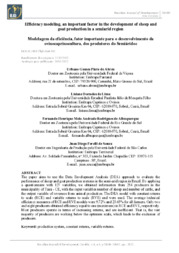Efficiency modeling, an important factor in the development of sheep and goat production in a semiarid region.
Efficiency modeling, an important factor in the development of sheep and goat production in a semiarid region.
Author(s): ABREU, U. G. P. de; LIMA, L. D. de; ALBUQUERQUE, F. H. M. A. R. de; SOUZA, J. D. F. de
Summary: The paper aims to use the Data Envelopment Analysis (DEA) approach to evaluate the performance of sheep and goat production systems in the semi-arid region in Brazil. By applying a questionnaire with 127 variables, we obtained information from 254 producers in the municipality of Tauá - CE, with the input variables number of sheep and number of cattle, and the output variable of revenues from animal production. The DEA model with constant returns to scale (RCE) and variable returns to scale (RVE) and were used. The average technical efficiency measures of RCE and RVE models were 9.72% and 23.65% for all farmers. Only two and eight producers obtained efficiency equal to one (maximum) in RCE and RVE, respectively. Most producers operate in terms of increasing returns, and are inefficient. That is, the vast majority of producers are working below the optimum scale, which leads to the exclusion of producers.
Publication year: 2022
Types of publication: Journal article
Unit: Embrapa Pantanal
Keywords: Animal production, Caprino, Caprinocultura, Ovino, Ovinocultura, Sistema de Produção
Observation
Some of Embrapa's publications are published as ePub files. To read them, use or download one of the following free software options to your computer or mobile device. Android: Google Play Books; IOS: iBooks; Windows and Linux: Calibre.
Access other publications
Access the Agricultural Research Database (BDPA) to consult Embrapa's full library collection and records.
Visit Embrapa Bookstore to purchase books and other publications sold by Embrapa.

